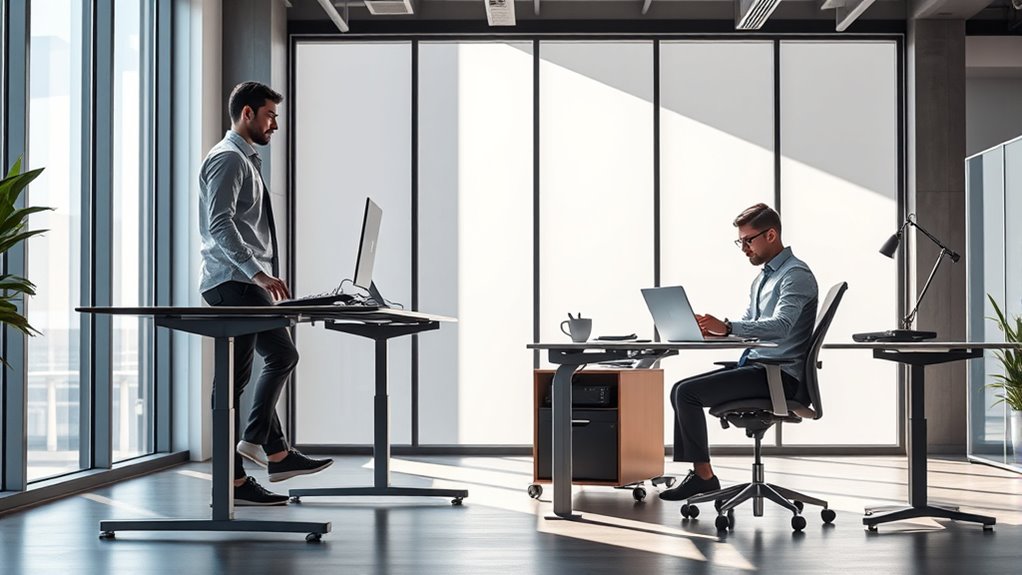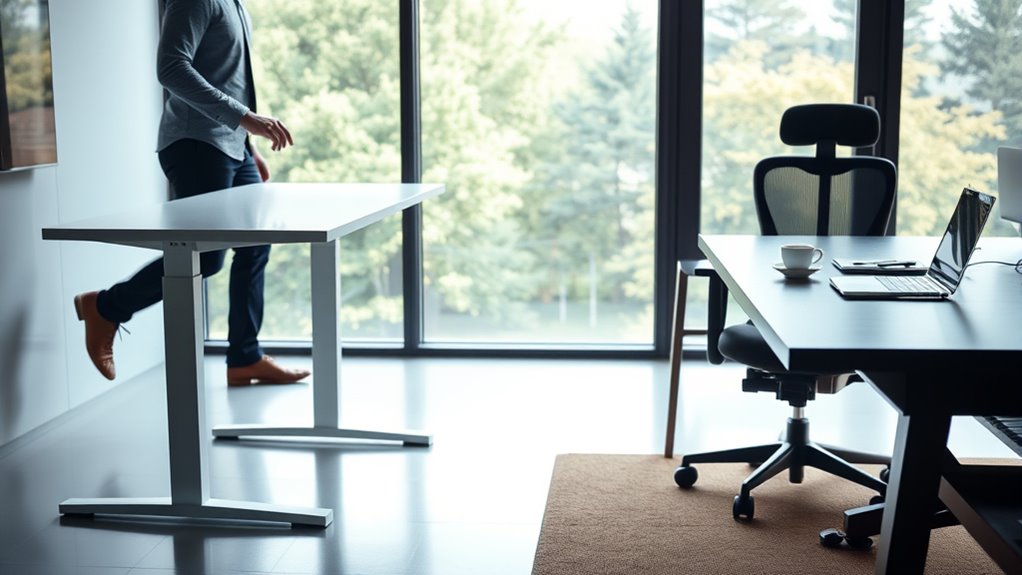Recent studies show that alternating between standing and sitting at your desk maximizes health benefits while reducing risks. Standing promotes better posture and can help combat back and neck pain, but standing too long can cause discomfort and circulation issues. Sitting alone increases the risk of heart disease and weight gain, but prolonged sitting isn’t ideal either. Using an adjustable desk and switching positions regularly can help create a healthier workspace—continue to explore how to get it just right.
Key Takeaways
- Recent studies highlight benefits of alternating between standing and sitting to improve posture and reduce musculoskeletal issues.
- Evidence suggests standing desks can lower back pain but may increase leg discomfort if used excessively without movement.
- Research emphasizes the importance of movement breaks regardless of desk type to mitigate health risks associated with prolonged sitting or standing.
- Data shows that adjustable desks supporting dynamic postures are more effective for long-term health than fixed sitting or standing setups.
- Overall, studies recommend a balanced approach combining ergonomic practices, movement, and flexibility for optimal health benefits.

Choosing between standing and sitting desks can considerably impact your health and productivity. As you weigh your options, it’s essential to consider the ergonomic benefits each setup offers and the potential health risks associated with prolonged use of either. Standing desks are often praised for promoting better posture and reducing the strain that comes from sitting all day. When properly adjusted, they encourage you to maintain a natural spine alignment, which can alleviate common issues like back pain and neck tension. This ergonomic advantage supports a more active working style, helping prevent musculoskeletal problems that develop from poor ergonomics over time.
Standing desks promote better posture and reduce strain when properly adjusted.
However, it’s not just about standing; it’s about how you use the standing desk. Standing for hours without movement can lead to its own health risks, such as increased pressure on your legs and feet, swelling, or varicose veins. You might also find yourself experiencing fatigue or discomfort if you don’t incorporate regular movement or sit down periodically. The key is to strike a balance—alternating between sitting and standing can maximize ergonomic benefits while minimizing health risks. Adjustable desks that allow you to smoothly switch between positions become invaluable in this regard, as they enable you to customize your workspace based on your comfort and activity level.
On the other hand, sitting desks, especially traditional ones, are often associated with sedentary work, which carries its own set of health risks. Extended sitting has been linked to a higher risk of cardiovascular disease, obesity, and metabolic issues. Sitting for long periods can also contribute to poor posture, leading to chronic back and neck pain. To counteract these risks, many ergonomic experts recommend incorporating movement breaks and ergonomic accessories, such as supportive chairs and footrests, to improve posture and reduce strain. While sitting can be comfortable and familiar, it’s crucial to be mindful of the amount of time spent in this position and to adopt habits that promote movement and flexibility. Incorporating dynamic work habits can help mitigate some of the health issues associated with prolonged sitting.
Ultimately, the choice between standing and sitting desks isn’t solely about one being better than the other. Instead, it’s about understanding how to leverage the ergonomic benefits of each and mitigate their health risks. By adopting an adjustable desk and varying your posture throughout the day, you can create a healthier, more productive workspace. The latest studies highlight the importance of movement and ergonomic awareness, reminding you that no single approach is perfect; what matters most is how you implement these strategies into your daily routine.
Frequently Asked Questions
How Do Standing Desks Affect Long-Term Posture?
Standing desks can positively impact your long-term posture by enhancing ergonomic benefits and encouraging better muscle engagement. When you stand, you activate core and back muscles, reducing strain and promoting proper alignment. Over time, this helps prevent poor posture habits that develop from prolonged sitting. You’ll likely notice improved comfort and spinal health, making standing desks a valuable tool for maintaining good posture and reducing discomfort during your workday.
Are Adjustable Desks Better Than Fixed Standing or Sitting Desks?
You’ll find adjustable desks better than fixed ones because they let you customize the desk height to fit your needs, promoting better ergonomics. With ergonomic accessories like keyboard trays and monitor stands, you can optimize your setup further. Adjustable desks encourage movement and flexibility, reducing strain and discomfort. Overall, they support a healthier, more comfortable workspace, making them a smarter choice for long-term comfort and productivity.
What Are the Health Risks of Prolonged Standing at a Desk?
Imagine standing all day like a tightrope walker, balancing precariously. Prolonged standing can strain your legs and lower back, risking joint pain and varicose veins. It may also impact your cardiovascular health by increasing blood pressure. To stay safe, use ergonomic accessories like anti-fatigue mats and take regular breaks. Alternating between sitting and standing helps prevent these risks, keeping your body balanced and healthy.
How Can I Prevent Fatigue When Using a Standing Desk?
To prevent fatigue when using a standing desk, you should incorporate ergonomic accessories like anti-fatigue mats and supportive footrests. These help reduce pressure on your feet and improve comfort. Remember to shift your weight, take regular breaks, and stretch frequently. Wearing comfortable shoes also boosts foot comfort, making your standing sessions more sustainable. By staying mindful of these tips, you’ll minimize fatigue and maintain productivity throughout your workday.
Do Standing Desks Improve Productivity and Focus?
You might find that standing desks can boost your productivity and focus, especially when you use ergonomic accessories like anti-fatigue mats and adjustable monitor arms. These tools help reduce physical stress, keeping you comfortable and alert. By minimizing discomfort and promoting better posture, standing desks encourage sustained concentration, allowing you to work more efficiently. Incorporating these features helps create an environment conducive to longer, more focused work sessions.
Conclusion
Ultimately, choosing between standing and sitting desks is like balancing on a tightrope—you don’t want to tip too far in either direction. Latest studies show that mixing both can boost your health and productivity. So, switch it up throughout the day, much like a dance, to keep your body energized and your mind sharp. Remember, finding the right rhythm keeps you moving forward without losing your footing.









